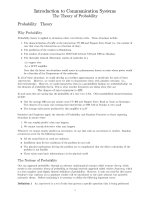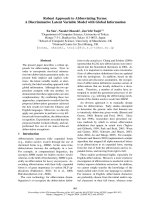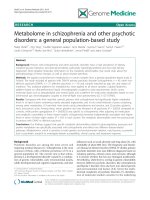Introduction to communication disorders a lifespan evidence based perspective 5th global edition by owens
Bạn đang xem bản rút gọn của tài liệu. Xem và tải ngay bản đầy đủ của tài liệu tại đây (27.62 MB, 481 trang )
Introduction to Communication Disorders
A Lifespan Evidence-Based Perspective
For these Global Editions, the editorial team at Pearson has
collaborated with educators across the world to address a wide
range of subjects and requirements, equipping students with the best
possible learning tools. This Global Edition preserves the cutting-edge
approach and pedagogy of the original, but also features alterations,
customization and adaptation from the North American version.
Global
edition
Global
edition
Global
edition
I ntroduction to Communication
Disorders
A Lifespan Evidence-Based Perspective
f ifTH edition
R
obert E. Owens, Jr. • Kimberly A. Farinella • Dale Evan Metz
fifTH
edition
Owens
Farinella
Metz
This is a special edition of an established title widely
used by colleges and universities throughout the world.
Pearson published this exclusive edition for the benefit
of students outside the United States and Canada. If you
purchased this book within the United States or Canada
you should be aware that it has been imported without
the approval of the Publisher or Author.
Pearson Global Edition
Owens_1292058897_mech.indd 1
08/07/14 5:41 PM
Introduction to
Communication
Disorders
A Lifespan Evidence-Based Perspective
Global
Edition
Robert E. Owens, Jr.
College of St. Rose
Kimberly A. Farinella
Northern Arizona University
Dale Evan Metz
State University of New York at Geneseo, Emeritus
Boston Columbus Indianapolis New York San Francisco Upper Saddle River
Amsterdam Cape Town Dubai London Madrid Milan Munich Paris Montreal Toronto
Delhi Mexico City Sao Paulo Sydney Hong Kong Seoul Singapore Taipei Tokyo
A01_OWEN8894_05_GE_FM.INDD 1
7/4/14 6:56 AM
Vice President, Editorial Director: Jeffery W. Johnston
Executive Acquisitions Editor: Ann Davis
Executive Field Marketing Manager: Krista Clark
Senior Product Marketing Manager: Christopher Barry
Project Manager: Annette Joseph
Head of Learning Asset Acquisition, Global Edition:
Laura Dent
Acquisitions Editor, Global Edition: Sandhya Ghoshal
Assitant Project Editor, Global Edition: Sinjita Basu
Senior Manufacturing Controller, Production,
Global Edition: Trudy Kimber
Full-Service Project Management: Jouve India
Cover Designer: Lumina Datamatics
Cover Photo: Shutterstock/nchlsft
Cover Printer: Ashford Colour Press
Pearson Education Limited
Edinburgh Gate
Harlow
Essex CM20 2JE
England
and Associated Companies throughout the world
Visit us on the World Wide Web at:
www.pearsonglobaleditions.com
© Pearson Education Limited 2015
The rights of Robert E. Owens, Jr., Kimberly A. Farinella, and Dale Evan Metz to be identified as the authors of this work
have been asserted by them in accordance with the Copyright, Designs and Patents Act 1988.
Authorized adaptation from the United States edition, entitled Introduction to Communication Disorders: A Lifespan EvidenceBased Perspective, 5th edition, ISBN 978-0-133-35203-0, by Robert E. Owens, Jr., Kimberly A. Farinella, and Dale Evan Metz,
published by Pearson Education © 2015.
All rights reserved. No part of this publication may be reproduced, stored in a retrieval system, or transmitted in any form
or by any means, electronic, mechanical, photocopying, recording or otherwise, withouteither the prior written permission
of the publisher or a license permitting restricted copying in the United Kingdom issued by the Copyright Licensing Agency
Ltd, Saffron House, 6–10 Kirby Street, London EC1N 8TS.
All trademarks used herein are the property of their respective owners.The use of any trademark in this text does not vest in
the author or publisher any trademark ownership rights in such trademarks, nor does the use of such trademarks imply any
affiliation with or endorsement of this book by such owners.
ISBN 10: 1-292-05889-7
ISBN 13: 978-1-292-05889-4
British Library Cataloguing-in-Publication Data
A catalogue record for this book is available from the British Library
10 9 8 7 6 5 4 3 2 1
14 13 12 11 10
Typeset in ITC Mendoza Roman Std by Jouve India.
Printed in Great Britain By Ashford Colour Press Ltd, Gosport.
A01_OWEN8894_05_GE_FM.INDD 2
7/4/14 6:56 AM
Wendy Metz,
MS, CCC-SLP,
wife, colleague, mentor, and friend
A01_OWEN8894_05_GE_FM.INDD 3
7/4/14 6:56 AM
A01_OWEN8894_05_GE_FM.INDD 4
7/4/14 6:56 AM
Preface
ntroducing a new edition is always exciting and exhausting. In preparing a new edition, especially an introductory text, there is always the
question of balance. Did we provide enough detail? Too much? Did we
get the perspective correct? We hope that those of you who are familiar
with the previous editions will agree with us that this edition is a worthy introduction to the field of speech pathology and audiology and one that contributes
meaningfully to the education of speech-language pathologists and audiologists.
Within each chapter, we have attempted to describe a specific type of disorder and related assessment and intervention methods. In addition, we have
included lifespan issues and evidence-based practice to provide the reader with
added insights. Each type of disorder is illustrated by personal stories of individuals with that disorder. Further knowledge can be gained through the suggested
readings provided at the conclusion of each chapter.
I
New to this Edition
This fifth edition of Introduction to Communication Disorders has many new features that strengthen the existing material in the previous edition. These include
the following:
• Chapters have been reorganized and rewritten to help conceptualize the
information differently so as to conform more to current clinical and educational categories. Several chapters have been reworked entirely.
• The reorganization of the entire book has resulted in fewer chapters—in
part to respond to instructors’ concerns about covering the material in a
semester. We do listen!
• Of course, the material in each chapter has been updated to reflect the
current state of clinical research. Special attention has been paid to the
growing body of e vidence-based research and literature. A quick perusal
of the references will verify the addition of hundreds of new professional
articles.
• As in the past, we have worked to improve readability throughout the book
and to provide the right mix of information for those getting their first
taste of this field. Several professors and students have commented favorably on our attempt in previous editions to speak directly to the reader,
and we have continued and expanded this practice.
• We have continued to provide e vidence-based practices in concise,
easy-to-read boxes within each chapter. This demonstrates our commitment to this practice begun in the previous edition. As with all the rest
of the text, these boxes have been updated to reflect our best knowledge
to date.
• Background information has been simplified and shortened, in response
to input from professors who felt we had provided too much and that
5
A01_OWEN8894_05_GE_FM.INDD 5
7/4/14 6:56 AM
6
Preface
this information would be covered in other introductory course in anatomy and physiology, language development, and phonetics. This change
increases readability and decreases the burden on faculty who felt compelled to teach it all.
Acknowledgments
Robert Owens
I would like to thank the faculty of the Department of Communication Sciences
and Disorders and the entire faculty and administration at the College of St. Rose
in Albany, New York. What a wonderful place to work and to call home. The college places a premium on scholarship, student education, professionalism, and a
friendly and supportive workplace environment and recognizes the importance of
our field. I am indebted to all for making my new academic home welcoming and
comfortable. I am especially thankful to President Margaret “Maggie” Kirwin,
Interim School of Education Dean Margaret McLane, my chair Jim Feeney, and
my colleagues in my department, fellow faculty members Dave DeBonis, Colleen
Karow, Megan Overby, Jack Pickering, Anne Rowley, Jessica Kisenwether, and
Julia Unger, and fellow clinical faculty members Kim Lamparelli, Elizabeth Baird,
Marisa Bryant, Wyndi Capeci, Sarah Coons, Elaine Galbraith, Julie Hart, Barbara
Hoffman, Jackie Klein, Kate Lansing, Jessica Laurenzo, Melissa Spring, and Lynn
Stephens. You have all made me feel welcomed and valued.
It is with some sadness that I remember my colleagues at my former institution, State University of New York at Geneseo and the demise of the Department
of Communicative Disorders and Sciences due to a shortsighted college administration decision. These great folks include Rachel Beck, Irene Belyakov, Linda
Deats, Brenda Fredereksen, Beverly Henke-Lofquist, Thomas House, Carol Ivsan,
Cheryl Mackenzie, Doug MacKenzie, Dale Metz, Diane Scott, Gail Serventi, and
Bob Whitehead. All of us are indebted to the chair Linda House, who helped us
keep our dignity and our promise to students in the face of a terrible and demoralizing situation. Best to you all always.
I would be remiss if I did not acknowledge the continuing love and support
I receive from Addie Haas. She was with us in the first and second editions and
continues to be a source of inspiration.
Finally, my most personal thanks and love goes to my spouse and partner,
who supported and encouraged me and truly makes my life fulfilling and happy.
I’m looking forward to our life together.
Kimberly Farinella
I wish to sincerely thank Bob Owens, Dale Metz, and Steve Dragin for again
including me on this new and exciting edition of the textbook. I remain perpetually in awe of the fact that I work with such brilliant people, and I’m truly grateful for the opportunity.
I would also like to thank the faculty, staff, and students in the Department
of Communication Sciences and Disorders at Northern Arizona University for
their help and support of this current edition of the textbook. I especially want
A01_OWEN8894_05_GE_FM.INDD 6
7/4/14 6:56 AM
Preface
7
to thank my dear friend and colleague, Dr. Emi Isaki, for her contributions to
the Disorders of Swallowing chapter, and also to our graduate assistants at NAU,
Susan Williams and Sonia Mehta, for their photo contributions.
I want to thank my family, especially my parents, for their continued support of my career, and I want to express my gratitude to my significant other and
future spouse, Tom Parker. I look forward to a long and happy life with you with
plenty of skiing in the beautiful mountains of Flagstaff, Arizona!
The following reviewers offered many fine suggestions for improving
the manuscript: Tausha Beardsley, Wayne State University; Wendy Bower,
State University of New York at New Paltz; Louise Eitelberg, William Paterson
University. Their efforts are sincerely acknowledged.
Pearson wishes to thank Dr. Gatha Sharma for her contribution to the Global
Edition.
A01_OWEN8894_05_GE_FM.INDD 7
7/4/14 6:56 AM
A01_OWEN8894_05_GE_FM.INDD 8
7/4/14 6:56 AM
Brief Contents
Chapter 1
Communicative Disorders and Clinical Service 23
Chapter 2
Communication: Means, Impairments,
Intervention 37
Chapter 3
The Biological Mechanism of Speech 63
Chapter 4
Language Impairments in Children 79
Chapter 5
Literacy Impairments: Assessment and
Intervention 125
Chapter 6
Language Impairments in Adults 159
Chapter 7
Stuttered Speech 205
Chapter 8
Voice and Resonance Disorders 225
Chapter 9
Disorders of Articulation and Phonology 251
Chapter 10 Motor Speech Disorders 281
Chapter 11 Dysphagia 307
Chapter 12 Audiology and Hearing Loss 331
David A. DeBonis, Ph.D.
Chapter 13 Using Augmentative and Alternative
Communication 377
James Feeney, Ph.D.
Appendix
Professional Organizations 401
9
A01_OWEN8894_05_GE_FM.INDD 9
7/4/14 6:56 AM
A01_OWEN8894_05_GE_FM.INDD 10
7/4/14 6:56 AM
Contents
Chapter 1
Communicative Disorders and Clinical Service23
Helping others to Help Themselves 24
Communication Disorders 24
The Professionals 25
Audiologists 25
Speech-Language Pathologists 27
Speech, Language, and Hearing Scientists 28
Professional Aides 30
Related Professions: A Team Approach 30
Service Through the Lifespan 30
Evidence-Based Practice 32
Communication Disorders in Historical Perspective 34
Summary 35
Suggested Readings 36
Chapter 2 Communication: Means, Impairments, Intervention37
Human Communication 38
The Social Animal 38
Means of Communication 38
Communication through the Lifespan 44
Communication Impairments 47
Language Disorders 49
Speech Disorders 50
Hearing Disorders 51
Auditory Processing Disorders 52
How Common Are Communication Disorders? 52
Deciding Whether there Is a Problem 55
Defining the Problem 56
Assessment Goals 56
Assessment Procedures 57
Intervention with Communication Disorders 59
Objectives of Intervention 59
Target Selection 59
Baseline Data 60
11
A01_OWEN8894_05_GE_FM.INDD 11
7/4/14 6:56 AM
12
Contents
Behavioral Objectives 60
Clinical Elements 60
Measuring Effectiveness 61
Follow-up and Maintenance 61
Summary 62
Suggested Readings 62
Chapter 3
The Biological Mechanism of Speech63
The Physiological Subsystems Supporting Speech 64
The Respiratory System 64
The Phonatory System 69
The Vocal Folds 69
The Articulatory/Resonating System 71
The Speech Production Process 75
Summary 77
Suggested Readings 78
Chapter 4
Language Impairments in Children79
Language Development through the Lifespan 82
Pre-Language 82
Toddler Language 84
Preschool Language 85
School-Age and Adolescent Language 88
Associated Disorders and Related Causes 90
Intellectual Disability 92
Learning Disabilities 94
Specific Language Impairment 97
Autism Spectrum Disorder (ASD) 100
Brain Injury 104
Neglect and Abuse 105
Fetal Alcohol Syndrome and Drug-Exposed Children 106
Other Language Impairments 107
Conclusion 107
Aspects of Language Affected 108
Assessment 108
Bilingual Children, English Language Learners, and Dialectal Speakers 110
Referral and Screening 110
Case History and Interview 111
A01_OWEN8894_05_GE_FM.INDD 12
7/4/14 6:56 AM
Contents
13
Observation 111
Testing 111
Sampling 114
Intervention 116
Target Selection and Sequence of Training 117
Evidence-Based Intervention Principles 117
Intervention Procedures 117
Intervention through the Lifespan 121
Summary 123
Suggested Readings 123
Chapter 5
Literacy Impairments: Assessment and Intervention125
Reading 128
Phonological Awareness 128
Morphological Awareness 129
Comprehension 130
Reading Development through the Lifespan 130
Reading Problems through the Lifespan 133
Assessment of Developmental Reading 137
Intervention for Developmental Reading Impairment 140
Writing 146
Spelling 147
Writing Development through the Lifespan 147
Writing Problems through the Lifespan 149
Assessment of Developmental Writing 151
Intervention for Developmental Writing Impairment 152
Summary 158
Suggested Readings 158
Chapter 6
Language Impairments in Adults159
Language Development through the Lifespan 161
Use 161
Content 162
Form 162
The Nervous System 162
Central Nervous System 163
Aphasia 165
Concomitant or Accompanying Deficits 168
Types of Aphasia 170
A01_OWEN8894_05_GE_FM.INDD 13
7/4/14 6:56 AM
14
Contents
Causes of Aphasia 174
Lifespan Issues 176
Assessment for Aphasia 178
Intervention 181
Evidence-Based Practice 184
Conclusion 185
Right Hemisphere Brain Damage 186
Characteristics 186
Assessment 189
Intervention 189
Traumatic Brain Injury (TBI) 191
Characteristics 192
Lifespan Issues 193
Assessment 195
Intervention 195
Dementia 197
Alzheimer’s Disease 198
Summary 202
Suggested Readings 203
Chapter 7
Stuttered Speech205
Fluent Speech vs. Stuttering 208
Normal Disfluencies 208
Stuttered Disfluencies 208
The Onset and Development of Stuttering
through the Lifespan 210
The Effects of Stuttering through the Lifespan 212
Theories and Conceptualizations of Stuttering 214
Organic Theory 214
Behavioral Theory 215
Psychological Theory 215
Current Conceptual Models of Stuttering 215
Therapeutic Techniques Used with Young Children 216
The Evaluation of Stuttering 216
Indirect and Direct Stuttering Intervention 218
Therapeutic Techniques used with Older Children
and Adults Who Stutter 219
Fluency-Shaping Techniques 219
Stuttering Modification Techniques 221
Selecting Intervention Techniques 222
A01_OWEN8894_05_GE_FM.INDD 14
7/4/14 6:56 AM
Contents
15
The Effectiveness of Stuttering Intervention
through the Lifespan 222
Efficacy of Intervention with Preschool-Age Children 222
Efficacy of Intervention with School-Age Children 223
Efficacy of Intervention with Adolescents and Adults 224
Summary 224
Suggested Readings 224
Chapter 8
Voice and Resonance Disorders225
Normal Voice and Resonance Production 226
Vocal Pitch 226
Vocal Loudness 227
Resonance 228
Voice Disorders 228
Disorders of Vocal Pitch 229
Disorders of Vocal Loudness 229
Disorders of Vocal Quality 229
Nonphonatory Vocal Disorders 230
Voice Disorders Associated with Vocal Misuse or Abuse 231
Voice Disorders Associated with Medical or
Physical Conditions 235
Voice Disorders Associated with Hypoadduction 235
Voice Disorders Associated with Hyperadduction 236
Other Conditions That Affect Voice Production 236
Voice Disorders Associated with Psychological or
Stress Conditions 238
Resonance Disorders 238
Evaluation and Management of Voice and
Resonance Disorders 239
The Voice Evaluation 239
The Resonance Evaluation 240
Intervention for Voice Disorders Associated with Vocal
Misuse or Abuse 242
Intervention for Voice Disorders Associated with Medical or
Physical Conditions 242
Intervention for Voice Disorders Associated with Psychological or
Stress Conditions 243
Elective Voice Intervention for Transgender/Transsexual Clients 243
Treatment of Resonance Disorders 244
Efficacy of Voice and Resonance Treatment 246
Summary 248
Suggested Readings 249
A01_OWEN8894_05_GE_FM.INDD 15
7/4/14 6:56 AM
16
Contents
Chapter 9
Disorders of Articulation and Phonology251
Understanding Speech Sounds 253
Classification of Consonants by Place and Manner 253
Classification of Vowels by Tongue and Lip Position and Tension 254
Distinctive Feature Analysis 255
Speech-Sound Development through
the Lifespan 255
Pre-Speech 255
Toddler Speech 258
Preschool Speech 259
School-Age Speech 260
Phonology and Articulation 260
Associated Disorders and Related Causes 261
Developmental Impairment in Children 261
Language Impairments 262
Hearing Impairments 263
Neuromuscular Disorders 264
Childhood Apraxia of Speech 265
Structural Functional Abnormalities 266
Language and Dialectal Variations 266
Characteristics of Articulation and Phonology 268
Lifespan Issues 268
Assessment 268
Description of Phonological and Articulatory Status 268
Prognostic Indicators 271
Consistency 271
Stimulability 272
Intervention 273
Target Selection 273
Intervention Approaches 273
Treatment of Neurologically Based Motor-Speech
Disorders 277
Generalization and Maintenance 278
Summary 278
Suggested Readings 278
Chapter 10 Motor Speech Disorders281
Motor Speech Control 282
Structures of the Brain Important for Motor Speech Function 282
Motor Speech Production Process 285
Cranial Nerves Important for Speech Production 285
A01_OWEN8894_05_GE_FM.INDD 16
7/4/14 6:56 AM
Contents
17
Motor Speech Disorders 285
Dysarthria 285
Apraxia of Speech 292
Etiologies of Motor Speech Disorders 295
Cerebral Palsy 295
Evaluation of Motor Speech Disorders 300
Treatment of Motor Speech Disorders 301
Management of Dysarthria 301
Management of Acquired Apraxia of Speech 303
Summary 304
Suggested Readings 305
Chapter 11 Dysphagia307
Lifespan Perspectives 309
The Swallowing Process 310
Oral Preparation Phase 310
Oral Phase 310
Pharyngeal Phase 310
Esophageal Phase 310
Disordered Swallowing 311
Oral Preparation/Oral Phase 311
Pharyngeal Phase 311
Esophageal Phase 311
Pediatric Dysphagia 311
Dysphagia in Adults 313
Evaluation for Swallowing 316
Screening for Dysphagia in Newborns and the Elderly 316
Case History and Background Information
Regarding Dysphagia 317
Clinical Assessment 318
Cognitive and Communicative Functioning 318
Instrumentation 321
Dysphagia Intervention and Treatment 323
Feeding Environment 323
Body and Head Positioning 323
Modification of Foods and Beverages 324
Behavioral Swallowing Treatments 325
Medical and Pharmacological Approaches 327
Prognoses and Outcomes for Swallowing
Disorders 328
A01_OWEN8894_05_GE_FM.INDD 17
7/4/14 6:56 AM
18
Contents
Summary 330
Suggested Readings 330
Chapter 12 Audiology and Hearing Loss331
David A. DeBonis, Ph.D.
Incidence and Prevalence of Hearing Loss 332
Classification of Impairment, Disability, and Handicap 333
Deafness, the Deaf Community, and Deaf Culture 333
What Is Audiology? 334
Educational Requirements and Employment for
Audiologists 335
Fundamentals of Sound 335
Anatomy and Physiology of the Auditory System 336
The Outer Ear 336
The Middle Ear 337
The Inner Ear 338
The Central Auditory System 339
Types of Hearing Loss and
Auditory Disorders 340
Conductive Hearing Loss 340
Sensorineural Hearing Loss 342
Mixed Hearing Loss 346
(Central) Auditory Processing Disorders 346
Hearing Loss through the Lifespan 348
Audiological Assessment Procedures 350
Referral and Case History 351
Otoscopic Examination 352
Electroacoustic and Electrophysiological Testing 352
Behavioral Testing 354
Aural (Audiological) Habilitation/Rehabilitation 363
Counseling 364
Amplification 365
Hearing Assistive Technology/Assistive Listening Devices 368
Auditory Training and Auditory Communication Modality 370
Visual Communication Modality 372
Treatment and Management of (Central) Auditory
Processing Disorders 373
Summary 374
Suggested Readings 375
A01_OWEN8894_05_GE_FM.INDD 18
7/4/14 6:56 AM
Contents
19
Chapter 13 Using Augmentative and Alternative Communication377
James Feeney, Ph.D.
Who Uses AAC? 379
Types of AAC 379
Unaided AAC: Gestures and Vocalizations 380
Unaided AAC: Manual Sign Systems 380
Aided AAC 382
Aided Symbols: Tangible Symbols 382
Aided Symbols: Pictorial Symbols 383
Aided Symbols: Orthography and Orthographic Symbols 384
Combinations of Aided and Unaided Systems 384
Access 384
Output 386
Assessment Considerations 388
Specific Assessment Considerations 390
AAC System Selection or Feature Matching 392
AAC Symbol Selection 392
AAC Vocabulary Selection 393
Intervention Considerations 393
Evidence-Based Practice (EBP) in AAC 397
Summary 399
Suggested Readings 400
Appendix
Professional Organizations 401
Glossary 405
References 417
Name Index 447
Subject Index 457
A01_OWEN8894_05_GE_FM.INDD 19
7/4/14 6:56 AM
A01_OWEN8894_05_GE_FM.INDD 20
7/4/14 6:56 AM
Introduction to
Communication
Disorders
A01_OWEN8894_05_GE_FM.INDD 21
7/4/14 6:56 AM
A01_OWEN8894_05_GE_FM.INDD 22
7/4/14 6:56 AM
1
Communicative
Disorders and
Clinical Service
CHAPTER LEARNING GoALS
When you have finished this chapter, you should be able to:
• Describe communication impairment
• Describe the roles of audiologists, speech‑language pathologists,
and speech, language, and hearing scientists
• Outline the history of changing attitudes toward individuals with
disabilities over the centuries and legislation over the past several
decades
• Describe how evidence‑based practice (EBP) influences clinical
decisions
M01_OWEN8894_05_GE_C01.INDD 23
7/4/14 6:57 AM
24
Chapter 1 • Communicative Disorders and Clinical Service
C
an you imagine life without communication? No talking, no listening,
no interacting with others? Communication is part of what makes us
human. Even minor or temporary problems with communication, such
as laryngitis, are often frustrating. Many of us have experienced a problem in speaking or listening at some time in our lives.
We hope through this text to explore the nature of communication
disorders. In this first chapter, we’ll introduce the professionals who work with
individuals who have communication disorders. These are audiologists, speech-
language pathologists, or speech/language scientists. We’ll also explore the roles
of other professional team members, where speech-language pathologists and
audiologists work, and what they do, plus we’ll explain the nature of EBP. This
first chapter also provides a historical perspective and outlines the laws that mandate appropriate care for those in need. Along the way, we’ll explore why people
choose these careers.
Helping Others to Help Themselves
Why does someone decide to become a speech-language pathologist (SLP) or
audiologist? It is mostly because of the satisfaction they receive from helping others to live a fuller life. Many—maybe even you—first became interested through a
personal or family encounter with a communication disorder or through a work
or volunteer experience with individuals with communication disorders. SLPs
and audiologists may also have chosen their careers because they want to be useful to society, to contribute to the general good.
Communication Disorders
We’ve mentioned communication disorders, but we haven’t been very specific.
It’s always good to agree on our topic in any type of communication, so let’s
begin here.
A communication disorder impairs the ability to both receive and send,
and also process and comprehend concepts or verbal, nonverbal and graphic
information. A communication disorder may affect hearing, language, and/or
speech processes; may range from mild to profound severity; and may be developmental or acquired. One or a combination of communication disorders may
be presented by an individual and may result in a primary disability or may be
secondary to other disabilities.
That’s a lot. In short, a communication disorder may affect any and all
aspects of communication, even gesturing. A communication disorder may affect
hearing, language (the code we use to communicate), and/or speech (our primary mode or manner of communication). This is reflected in American Speech
Language Hearing Association’s (ASHA) name. (The Appendix describes ASHA’s
role in more detail.) But communication impairments can affect much more
as you are about to explore through this book and the course you’re taking.
For example, SLPs are also involved in feeding and swallowing assessment and
intervention.
A speech disorder may be evident in the atypical production of speech
sounds, interruption in the flow of speaking, or abnormal production and/or
M01_OWEN8894_05_GE_C01.INDD 24
7/4/14 6:57 AM









